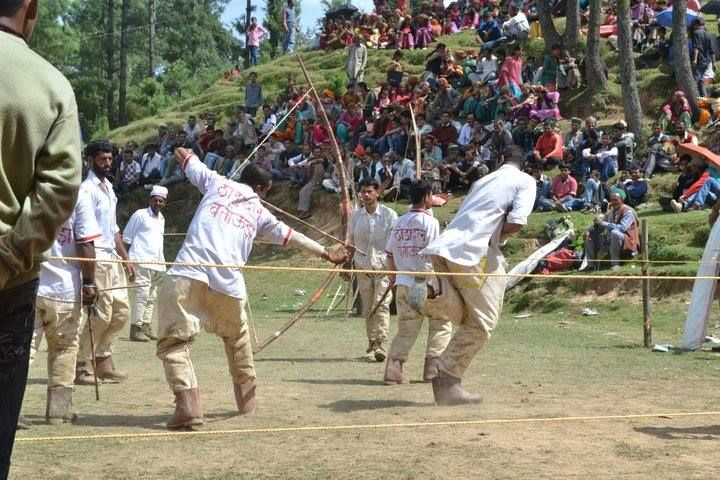
Thoda (Pradesh, India)
- Name of sport (game): Thoda
- Place of practice (continent, state, nation):
Pradesh, India
- Description:
This remnant of martial culture is popular in the districts of Shimla, Sirmaur and Solan. Probably best described as a group demonstration sport, "thoda" is the art of archery. It takes its name from the circular wooden ball used to replace the deadly arrowhead. Bows ranging in size from three and a half to six feet are used in its practice. The archers divide themselves into groups called the "Saathis" and the "Pashi," who are reputed to represent the descendants of the Pandavas and the Kauravas who in the days of the Mahabharata frequently battled in the Valleys of Kulu and Manali. Competition takes place yearly on Baisakhi Day (April 13th and 14th which honors the Goddesses Durga and Mashoo). The event takes place on a marked fairground as both groups face each other at a distance of approximately ten yards. Each group in turn fires its arrows, targeting the opponents' leg area beneath the knee. Points are detracted for hits to other areas. The defenders may dance about, side step and kick their legs in an effort to foil accurate aim. All the while, observers cheer from the sidelines while participating teams sing and play martial music.
Thoda is a martial art form from Himachal Pradesh, India. The sport demands excellent expertise in archery. The main weapons needed for Thoda are bows and arrows. In Thoda there are 2 groups. There are close to 500 people in one group, majority of them do no take part and are present just to cheer up the team. The two sides that take part are named as Saathi and Pashi since they are believed to be descendants of Pandavas and Kauravas. Unlike archery, the target of the competitors here is the opponents` leg; below the knee, where the opponent should aim his arrow.
The moment the two contesting groups reach the village fairground, both the parties dance on either side of the ground, waving their swords, aglitter in the sun, and sing and dance to the stirring martial music. The Pashi group forms achakravyuh, and blocks the Saathi group, who in turn begin to penetrate their defences. After the initial resistance, the Saathis reach the centre of the ground. The two groups stand 10 metres apart and prepare to attack. The defenders start shaking, kicking their legs to and fro with brisk movements, to thwart the accurate aim of their adversaries.
In fact the whole concept of the sport is to create a highly energetic atmosphere with non-stop leg kicking on one-hand and constant attempts to hit the target on the other. Lightning movements and agility are the sole methods of defence. The whole competition is conducted to the lively, virile rhythm of war dance, with one side furiously sidestepping, legs kicking in all directions, and other side doing its best to place an arrow on the target. If a defender is hit on the wrong part of the body, negative points are awarded. At present, the game is played in a marked court, which ensures that a certain degree of discipline.
Source: https://targetstudy.com/qna/what-is-thoda.html - Sources of information :
Articles:
https://targetstudy.com/qna/what-is-thoda.htmlVideo:
https://www.youtube.com/watch?v=F8L8j_8lPQo
https://www.youtube.com/watch?v=NAuO_5YIOsw
https://www.youtube.com/watch?v=c0xOTmqLsSYSource of photos used in this article and gallery:
https://pl.pinterest.com/pin/496310821410088514/
https://www.sportskeeda.com/slideshow/10-indian-sports-that-you-should-know-about?ref=relatedmid
https://homegrown.co.in/article/10332/the-amazing-lesser-known-sports-of-india - Gallery:

